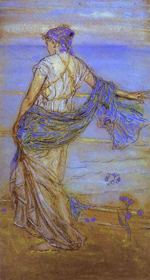
A Hieroglyphic World
“In reality they all lived in a kind of hieroglyphic world, where the real thing
was never said or done or even thought,
but only represented
by a set of arbitrary signs” (32).
Points
for Reflection
The Age of Innocence (1920), chps 1-14 (3-91)
- Archer believes himself adept at understanding others’ thoughts and unspoken desires. Does he understand himself?
- are the social “forms” rigorously held to by members of New York’s upper-class society generated by a preoccupation with honesty and truth?
- do the wealthy in New York rely more heavily on non-verbal forms of communication than on words?
- what do the Arts (literature, music, painting, etc.) give to Newland?
- does Newland Archer belong more to upper-class New York society, or artistic, bohemian society?
- does Newland appreciate Ellen more for who she is, or for what she represents to him?
- does Book I of this novel (thus far) deliver a consistent thesis concerning women’s rights?

Annabel Lee (c.1890)
James Whistler
Dr. Paul Marchbanks
pmarchba@calpoly.edu
![]()
